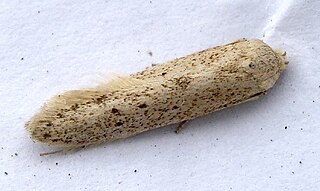
Blastobasis is the type genus of the gelechioid moth family Blastobasidae; in some arrangements these are placed in the case-bearer family (Coleophoridae) as a subfamily. Within the Blastobasidae, the subfamily Blastobasinae has been established to distinguish the Blastobasis lineage from the group around Holcocera, but the delimitation is not yet well-resolved.

Blastobasis adustella is a species of moth of the family Blastobasidae. It is endemic to Australian region, but was introduced in western Europe and is now reported from The Netherlands, Great Britain, Ireland, Madeira and the Azores
Blastobasis vittata is a moth of the family Blastobasidae. It was thought to be endemic to Madeira but is now known to inhabit the Netherlands, France, the Channel Islands, England and Northern Ireland.

Zealandopterix zonodoxa is a moth of the family Micropterigidae. It is endemic to New Zealand and is located from Hawkes Bay north as well as on Poor Knights, Little Barrier and the Great Barrier Islands. It is the smallest micropterigid in New Zealand and the shiny white markings on the forewing of this species display variation. It is a moth that is active during the day, but has been collected using UV light. Adults are on the wing from September to March and the species has been witnessed visiting the flowers of Nīkau and Cordyline pumilio in large numbers. It inhabits a wide variety of moist indigenous forest but is associated with forests in which podocarps are common. Larvae have been sieved from rotten wood on the floor of a mixed podocarp/broadleaf forest or extracted from moss or from bryophytes.

Sabatinca caustica is a species of moth belonging to the family Micropterigidae. It was described by Edward Meyrick in 1912. It is endemic to New Zealand and is found in both Southland and at Stewart Island / Rakiura. The adults of this species are variable in appearance with some specimens being mainly white on their forewings while others have forewings that are a more mottled purple-brown colour. Adults are on the wing from the start of October until the middle of December. Larvae feed on the surface of leafy liverworts.

Asterivora exocha is a species of moth in the family Choreutidae. It was first described by Edward Meyrick in 1907 and is endemic to New Zealand. This species has only been observed in the Humboldt Ranges of Otago and inhabits subalpine native bush at elevations of around 3600 ft. Adults of this species are on the wing in December and January and have been observed flying at dusk.

Asterivora nivescens is a species of moth in the family Choreutidae. It is endemic to New Zealand and has been observed in Nelson. This species inhabits native herbage on mountain sides. Adults of this species are on the wing in January.
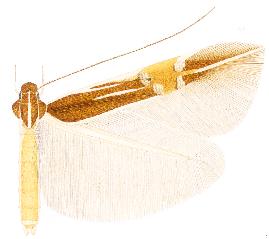
Cosmopterix erinome is a moth of the family Cosmopterigidae. It is known from the United States.
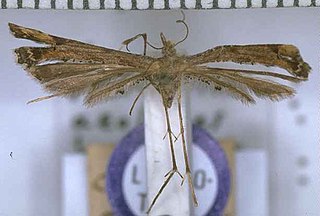
Amblyptilia aeolodes is a moth of the family Pterophoridae. This species was first described by Edward Meyrick in 1902. It is endemic to New Zealand and is found on the Chatham Islands, Big South Cape Island, and the subantarctic Auckland and Campbell Islands.The larvae feed on dicotyledonous herbs.

Pancalia leuwenhoekella is a moth in the family Cosmopterigidae.
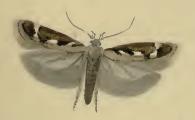
Caryocolum marmorea is a moth of the family Gelechiidae. It is found from Scandinavia to the Mediterranean islands, and from Ireland to Poland, Hungary and Greece. It is also found on the Canary Islands and Madeira. It is also found in North America.

Eudonia zophochlaena is a moth in the family Crambidae. It was described by Edward Meyrick in 1923. It is endemic to New Zealand. It has been hypothesised that this species is a North Island endemic. The adults of this species are on the wing from December until February. The larvae of this species are leaf miners of the leather-leaf fern Pyrrosia eleagnifolia.

Proteodes melographa is a species of moth in the family Depressariidae. It is endemic to New Zealand and has been observed at Mount Arthur and in the Nelson District. It inhabits forest in the alpine zone. The larvae of this species feeds on native beech trees.
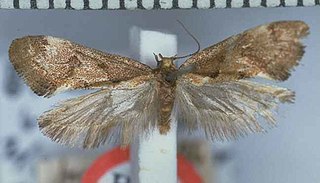
Tingena brachyacma is a species of moth in the family Oecophoridae. It is endemic to New Zealand and has been found in the south of the South Island. This species inhabits open swamps, native forest and scrubland and has been collected amongst Leptospermum. The adults of the species are on the wing in November and December.
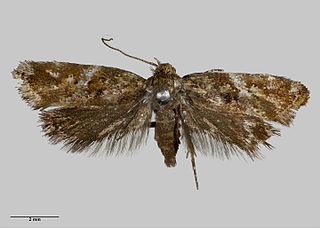
Tingena eumenopa is a species of moth in the family Oecophoridae. It is endemic to New Zealand and found in the North and South Islands. The adults have been found amongst tree ferns and are on the wing in December.

Tingena morosa is a species of moth in the family Oecophoridae. It is endemic to New Zealand and has been found in the South Island in Nelson including at the Dun Mountain and in the Canterbury region. This species inhabits native forest at altitudes from 2000 to 3000 ft. Adults of this species are on the wing in December.

Tingena opaca is a species of moth in the family Oecophoridae. It is endemic to New Zealand and has been observed in the southern parts of the South Island. Adults of this species are on the wing in December.

Meterana badia is a species of moth in the family Noctuidae. This species is endemic to New Zealand.

Helastia farinata is a moth of the family Geometridae. It was first described by William Warren in 1896. This species is endemic to New Zealand and is found in the North Island. H. farinata inhabits shady and damp forest ravines.
















